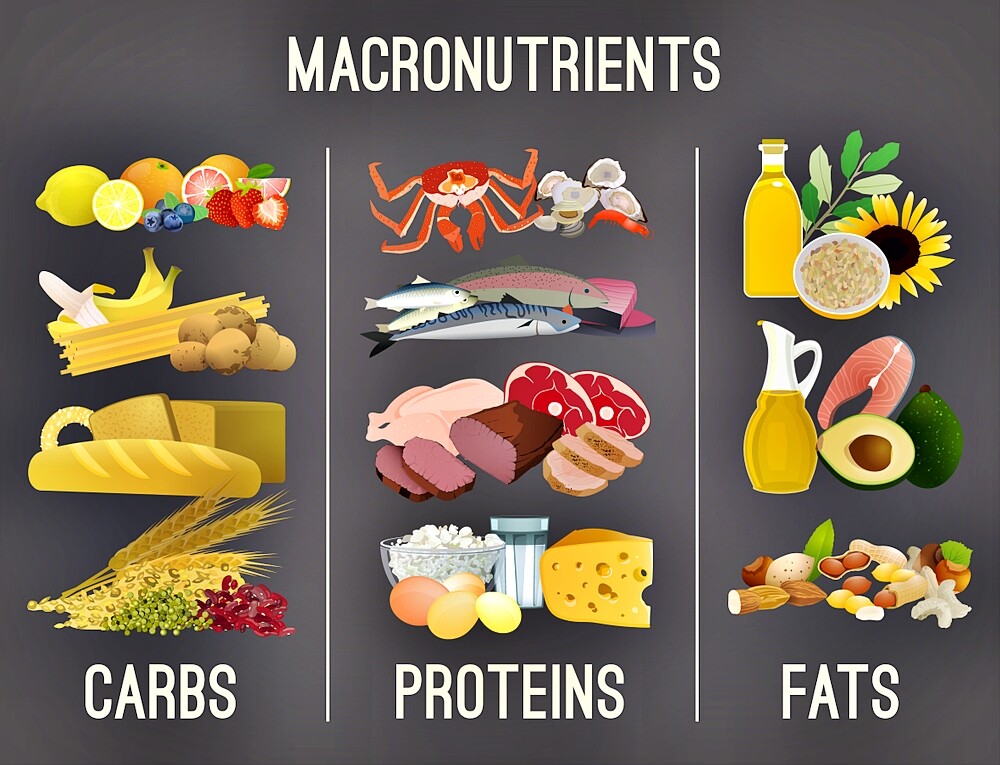If you are concerned with nutrition, sooner or later you will come across the concept of macronutrients. We’ll show you what’s behind them.
Macronutrients: What is that anyway?
Macronutrients, also known as “macros” for short, are the basic building blocks of our diet. Everything you eat is composed of one or more of these nutrients.
- Carbohydrates (4 kcal/g)
- Proteins (4 kcal/g)
- Fats (9 kcal/g)
Macronutrients provide our body with the energy (calories) it needs every day. If you supply your body with too many or too few calories or energy, you will gain or lose weight accordingly.
The carbohydrates
Carbohydrates, also called “Carbs”, are the most important building block that supplies our body with energy. They are themselves composed of different elements:
- Simple sugars (monosaccharides): fructose, glucose (dextrose), galactose
- Dual sugars (disaccharides): sucrose (household sugar), lactose
- Polysaccharides (oligosaccharides): Raffinose
- Complex carbohydrates (polysaccharides): amylopectin (vegetable starch), glycogen (animal starch), inulin
Carbohydrates are sometimes wrongly demonised by many people. Because carbohydrates refill your glycogen stores. One third of the glycogen is stored in the liver and two thirds in the muscles.
“Good” carbohydrates
Preferably complex carbohydrates should be taken in. They contain fibres (indigestible carbohydrates) which saturate you better and also provide you with important vitamins. They also keep your blood sugar level more stable. You can find out how to lose weight without sugar here.
In addition, a distinction is made between prebiotics and probiotics, which are said to have a positive effect on our health (intestines).
- Prebiotics: Foods with dietary fibres that serve as nutrients for the lower intestinal area – e.g. oat flakes, legumes
- Probiotics: Food with living microorganisms (bacteria) – e.g. cheese, yoghurt, kefir
The protein
Proteins, also known as egg white, are the essential substance for our muscles. However, they also support our immune system and also promote our hair, nails and skin.
In our body a continuous build-up and breakdown of cells takes place. We cannot store proteins in the long term, so our muscles, the largest source of protein storage, lose mass after a period without protein intake. Your body then uses the protein in your muscles for the more important processes of cell renewal.
With a healthy, balanced diet, you can normally cover your daily protein requirement – 0.8 to 1.2 grams per kilogram of body weight. Here is a brief overview of good protein sources:
- Meat
- Fish
- Dairy products
- Pulses
- Eggs
- Cereals
Proteins are composed of amino acids that are linked together. We distinguish between essential and non-essential amino acids. Our body cannot produce enough essential amino acids by itself, so we have to take them in through our diet.
The fats
Fats, also called lipids, are the flavour carrier in our diet. With 9 calories per gram, they are also the best supplier of energy. When we take in more fat than our body can store, it puts it into fat reserves.
Fats also fulfil important functions as building materials:
- Hormone production
- Absorption of fat-soluble vitamins (A, D, E, K)
- Protection of organs
Fats are formed from fatty acids. There are three different types.
1. Saturated fatty acids
- They are mostly found in animal products (cheese, butter) and vegetable fats (coconut oil).
- Saturated fatty acids are often classified as unhealthy. However, they also perform important functions as a building material.
- If you eat an animal diet, you probably already consume more than enough saturated fatty acids. As a vegetarian or vegan, you can eat nuts, seeds, avocados, chia seeds or coconut oil.
2. Unsaturated fatty acids
- Found mainly in vegetable oils as well as in nuts, avocados and fatty fish.
- Unsaturated fatty acids are considered to be extremely positive for health, especially for protecting the brain and inhibiting injuries. These fatty acids are also beneficial to the heart.
3. Trans fats
- The “nasty” fats are found in ready meals that are heavily processed or deep-fried.
- Trans fats are produced industrially. They lower your cholesterol levels and promote diseases.
- Look out for hydrogenated oils in the nutritional information.
Omega 3 vs. Omega 6
Omega fatty acids are essential and must therefore be taken in through the diet, just like essential amino acids. They belong to the polyunsaturated fatty acids and fulfil important functions, such as supporting the metabolism or strengthening the blood circulation.
Omega 3 in particular increases the “good” cholesterol (HDL) and protects the cardiovascular system.
Ideally, the ratio of Omega 6 to Omega 3 would be balanced. In the western world we are more likely to find values of 15:1 and higher. Therefore a 5:1 ratio is already a worthwhile goal.
Some Omega 3 sources:
- Salmon
- Tuna
- Trout
- Oils
- Nuts
Some Omega 6 sources:
- Sunflower oil
- Olive oil
- Beef
- Corn oil
- Soybean oil

